As you know, on Sunday’s – if I can – I like to visit a nice museum if possible while traveling.
On this snowy snowy New York Sunday afternoon, a priest friend and I made our way to the Metropolitan Museum of Art for the lighting of the Christmas Tree in the Medieval Hall.
We also explored some galleries. In our explorations, we saw some common features of many of the Italian late Medieval, early Renaissance depictions of Madonna and Child.
Little Jesus grabs or plays with Mother’s veil.
For example, here is one of The Goodhart Duciesque Master painted early, from 1315-30 using the Duccio motif of the Child playing with the veil of the Virgin. She looks out at us.
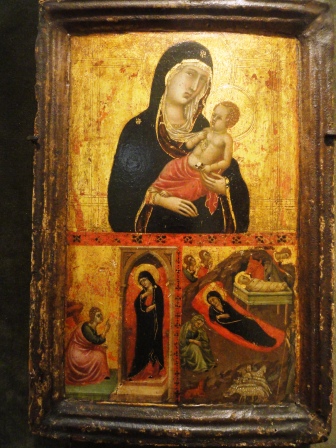
And he has a little flower, a carnation or “pink”.
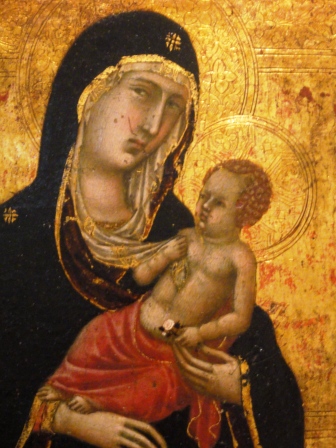
There is Duccio himself, of course!
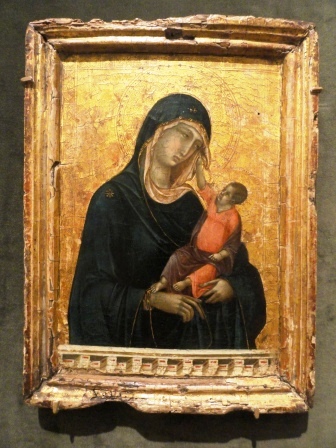
Taddeo Gaddi, a Florentine (+1366) did it too with this Madonna and Child Enthroned with Saints, rather old fashioned.
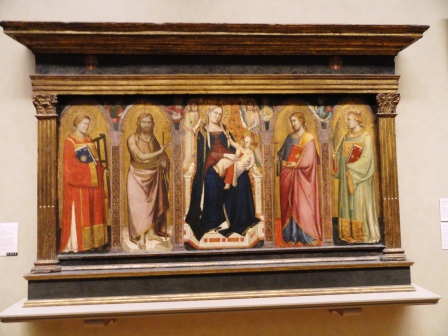
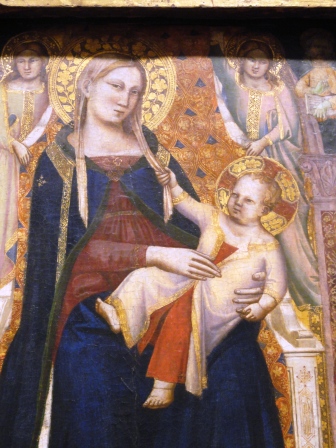
Lippo Memmi, Sienese, painted around 1350. This is a little variation. He is reaching in the same gesture as if for the tempting veil, but instead He’s giving Mother a little “pink”.
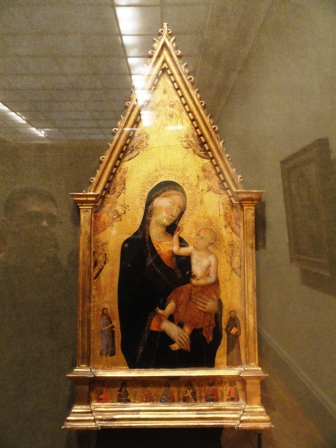
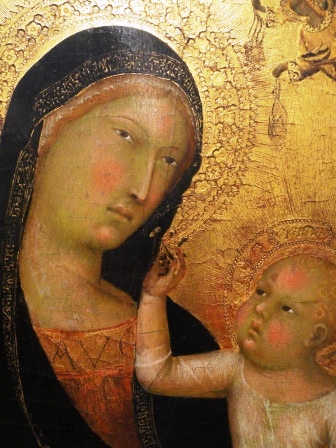
Sano di Pietro, Sienese (+1481) is still at the fun game of grab the veil, which is turning into a cloak.
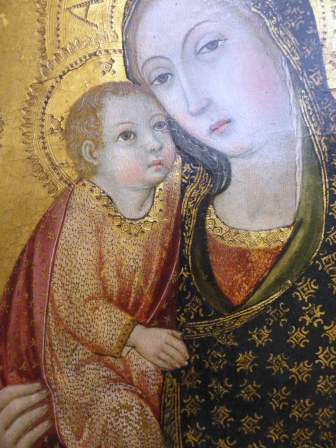
This painting of Jacopo Bellini, Venetian, painted around 1440, is in rough shape.You can see the game continues with the cloak veil.
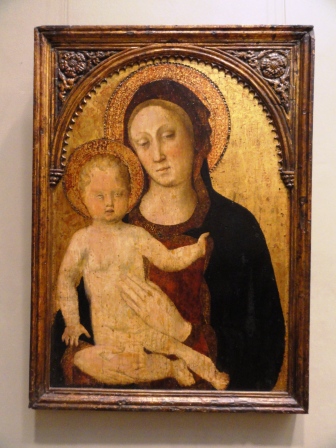
Michele da Verona, from, well… Verona, painted around 1490.
The style is changing as we move into the High Renaissance. We no longer have flat gold backgrounds. We are into landscapes and perspective. But Jesus still likes that veil, even while He blesses little John.
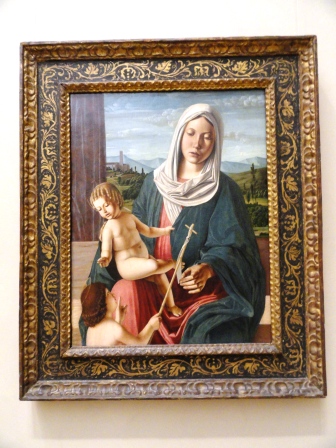
Andrea del Sarto, Florentine, died in 1530. It is harder to see here, but he is still at it.
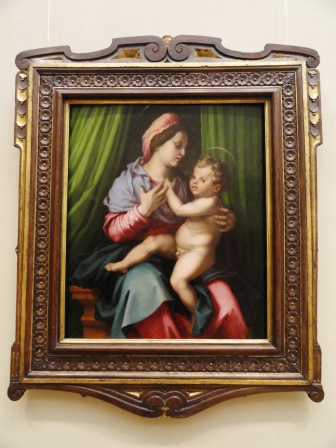
There are more… but that is a good overview.
It is the most human thing imaginable to see every little Bundle-Of-Joy, every Stupor Mundi, grabbing hold of things that are nearby, and what is more convenient that mommy’s hair or clothing or, in the case of the styles of the time, veils.
But there is probably a theological dimension to this in paintings, even as it seems to become a convention copied over and over again through the centuries, particularly in Italy and then in northern countries who use Italian conventions.
I haven’t looked into this, perhaps someone more expert in art can help me, but I suspect that this shows something of how the Lord is grasping our humanity to Himself, especially as it shifts to her blue mantle. Blue on the Virgin and on the Lord is often a symbol of humanity, while red is a symbol of divinity.


































Something with which moms who wear chapel veils at Mass are also familiar… somehow seeing the image of Baby Jesus pulling on Mary’s makes it more tolerable.
I’m guessing an allusion to the tearing of the veil in the temple.
It could be a device to emphasize His humanness, His being a child in the same way that children are children. I’m thinking of how in the image of Our Lady of Perpetual Help, Christ’s sandal is dangling from His foot.
I think I used to know an answer to this question, but have forgotten it, so I’ll speculate. In addition to the very good ideas above, it may also be that it is only in Christ that Mary’s glory is revealed – having the baby Jesus tug on her veil or even her outer blue cloak would hint at his ultimate future role in honoring his Mother – unveiling her true self, as it were.
The blue/red combination is interesting in this context – the inner garment of red, the color of the sun (at rising and setting) is, in the case of the Virgin, contained by the cloak of blue, the color of the sky. Her feminine, passive side is symbolically seen as containing a glorious, god-like interior, as she once contained the Christ Child on her lap. Note the way Mary’s red inner garment generally just peeks out from under her outer cloak, or, in some cases, is completely covered. She is not proclaiming her glory. It only makes sense that God would need to reveal her glory, as she accepts only the role of handmaid.
To A.D.J.S.,
I’m no art historian; however, someone once told me in reference to the image of Our Lady of Perpetual Help, that the baby Jesus’ sandal is dangling because his foot shook when he beheld the image of the cross and realized that he would die on it. I have no idea whether that’s a true account, but if even if it’s not, it’s certainly ‘ben trovato’.
It’s what babies do!!
He’s indicating the “protecting veil” (skepi) of the Theotokos (the subject of liturgical commemoration in the Byzantine rite).
Tin pasan elpida mou eis se anatithimi, Miter tou Theou; filaxon me ypo tin skepi sou.
All my hope I place in you, Mother of God; guard me under your protection.
Baby Jesus plays with His Mother’s veil in medieval sculpture, too.
Mary’s red garment symbolises her humanity, covered with a divine blue mantle. Jesus’s divine blue inner garment is clothed with the red cloak of the humanity he assumed.
At least for the earlier paintings where the Christ Child is tugging at Our Lady’s veil rather than her cloak – – Could it have something to do with the sacramental veil? That Christ is truly present in the Blessed Sacrament, but we see only the sacramental veil of the white bread? Maybe He is reminding us to hold fast to the sacraments?
Father Z.,
Duccio has painted a sorrowing mother
in fact’ Our Lady of Sorrows ‘contemplating
her newborn’s future suffering. The little Lord Jesus has just
used Her veil to wipe away a tear.
Early to high medieval artists very commonly depicted Mary
in a state of contemplative sorrow in ‘Mother and Child’ paintings.
Duccio is THE Master.Just beautiful.
I love Ishmael’s thoughts on this, but Father, your statement “I suspect that this shows something of how the Lord is grasping our humanity to Himself” made me think immediately of Philippians 2:6: “…though he was in the form of God, did not count equality with God a thing to be grasped.” It just paints an image for me of our Savior, with childlike glee, abandoning himself completely to the work of saving us. What a wonderful thought!
Thank you, Fr. Z. for posting your photos of these beautiful works of art. They are a window loooking in on the sacred. Our Lord, humble babe in the arms of our blessed Mother, Mary. I especially love little Lord Jesus giving his Mother a flower. Just beautiful and thank you for the art lessons, too.
Does anyone know for sure why baby Jesus is so often either barely clothed or not clothed at all? I think it has to be symbolic because mothers are inclined to use too much clothing, as protection, rather than too little. Then there are the swaddling clothes mentioned at Christ’s birth, which are nowhere to be seen unless it is a Nativity scene.
Beautiful photos, Father Z! And very neat explanations as to why the Infant Jesus is ‘grabbing’ His Mother’s veil!
Is it possible that the grasping of the veil is a Western version of Eastern iconography’s depictions of the Eleousa (“Virgin of Loving-Kindness”) in which the child Jesus touches Mary’s face? The following description is from Rowan Williams, Ponder These Things: Praying with Icons of the Virgin (Norwich: Canterbury Press, 2002), p. 21:
The Eleousa pattern is best known to Westerners through the great twelfth-century icon of the “Mother of God of Vladimir”: the child Christ embraces Mary, cheek to cheek, his arm encircles her neck, one foot is thrust towards us as if he is pushing himself up against her body with great energy, and his right hand grasps the corner of her veil. In some later versions, especially in Russia, he has one hand fondling her chin. Somewhere in the background of this image is the text from the Song of Songs (2:6) — “his left hand is beneath my head, and with his right hand he embraces me”.
Very familiar with that! I wonder how Our Lady kept hers on…not bobby pins probably.
The awesome singularity of the Virgin, God’s most/only perfect creature, made Queen of heaven and earth at the completion of her travails (unsurprisingly perfectly executed we might recall), seated at the right hand of God her father, spouse of the Holy Spirit, mother of the Word, whom she commanded as a child (and still does now, in a way that is a great mystery), complete authoritarian over the fallen angels. Need we go on? Hyperdulia knows no end!
This subject also reminds me of the depictions of the toddler Baptist annoying his infant Cousin while one or both mothers watch. Precious.
ToA.J.D.S. and Robert of Rome,
At a recent Carmelite retreat given around icons, the priest told us that the dangling shoe in Our Lady of Perpetual Help signifies how in the Old Testament a sandal was given or shared to seal a contract and that this represents the New Covenant of the Lord. I can’t remember all the details. Some of us had also heard that same thing about the cross but Father said it meant a covenant.
Beautiful discussion. Just looking at the pictures is refreshing.
The idea mentioned by a couple people above re: Mary’s sorrow even in these generally joyful images – it’s no coincidence that the Holy Innocents and St. Stephen follow right on the heels of Christmas.
I’m no scholar and forgive me if this isn’t kosher, but if anyone is interested, I did write up a little piece on a few aspects of Marian iconography as seen in Italian art over on my blog, since it seemed way too long for Fr. Z’s combox. It’s meant as a little background to this discussion.
“Does anyone know for sure why baby Jesus is so often either barely clothed or not clothed at all? I think it has to be symbolic…”
I think it is to show that He is really and truly a human baby.
Re. the comments by yatzer and Mariana: I saw a book review of an art history study dedicated to this, a couple years ago, and am not sure how to find the reference back, but as I recall, the argument was much the same as Mariana’s suggestion – to underline His Full Humanity, which includes being really and truly a Human Baby.
Thank you for this post!
(I am afraid my first thought was that this might point to a learned background to one of Ward Kimball’s ‘Art After-pieces’ where Our Lord is being all-too-human-babyishly uncareful of a book.)